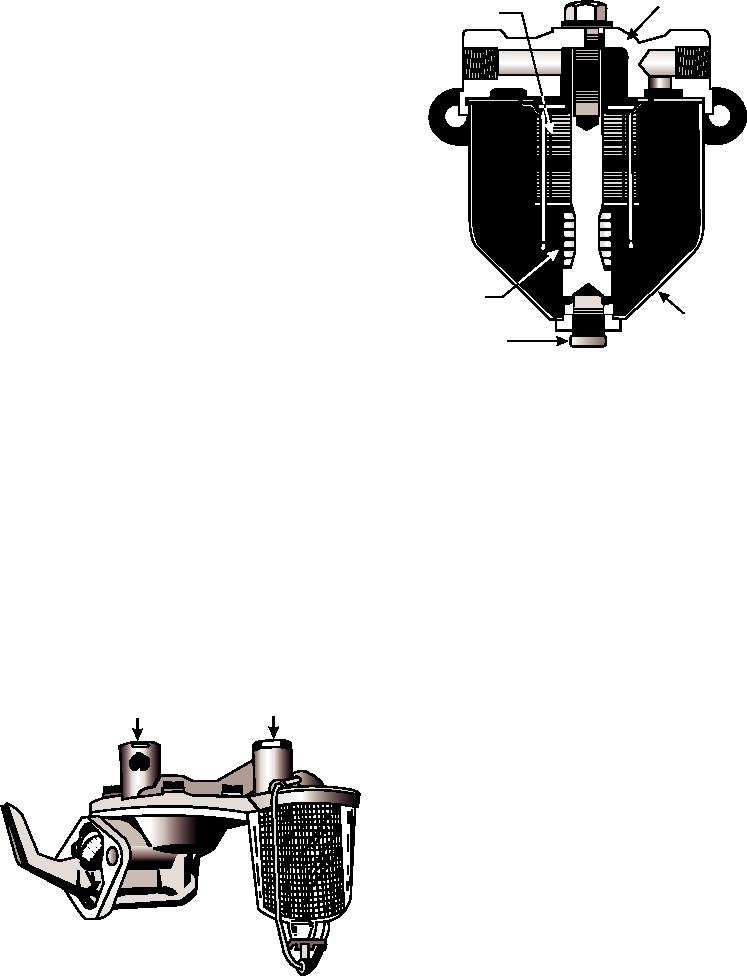
STRAINER
Fuel Tank Caps
COVER
ASSEMBLY
The fuel tank cap is designed to seal the filler tube
OUTLET
of the fuel tank and prevent the fuel from escaping on
INLET
hills and inclines. The cap allows air to enter the tank as
the fuel is used, or it seals the opening to the tank when
other means of ventilation are used to vent the tank.
Using the wrong type of cap can restrict the pumping
action of the fuel pump or it may cause the fuel tank to
collapse.
FUEL FILTERS
In figure 4-5, a common type of filter is shown
attached to the fuel pump. The fuel enters a bowl and
STRAINER
passes up through the filter screen, and then out through
SPRING
the outlet. Any water or solid matter caught by the filter
SHELL
falls to the bottom of the filter bowl. Dirt in the fuel
DRAIN PLUG
ASf04006
generally comes from rust scales in tank cars, storage
tanks, and drums. Water caught by the filter generally
Figure 4-6.--Fuel filter.
comes from condensation of moisture in the fuel tank or
is introduced through delivery from storage facilities.
The filter element is usually a fine metal-mesh screen.
FUEL PUMPS
Thumbscrews or spring wire clips hold the sediment
bulb in place against a cork washer.
The fuel pump must deliver enough fuel to supply
Another type of filter is made of a series of
the requirements of the engine, and also maintain a
laminated discs placed within a large bowl, which acts
proper pressure in the line between the fuel pump and
as a settling chamber for the fuel and encloses the discs
the carburetor.
or strainer assembly (fig. 4-6). Some vehicles use in
Excessive fuel-pump pressure holds the carburetor
line filters with either paper or ceramic elements. These
float needle off its seat, causing a high-gasoline level in
are replaced when the flow of fuel is restricted.
the float chamber, which, in turn, increases gasoline
Normally the filters are replaced during scheduled
consumption. Too low a fuel-pump pressure may cause
maintenance before becoming clogged and causing
an insufficient fuel flow into the carburetor and cause
unscheduled maintenance during operations.
air locks (vapor locks) to occur in the fuel lines. Air in
the fuel line will interrupt the flow of fuel to the
OUTLET
carburetor, resulting in engine power loss or
INLET
operational failure. The average fuel pump operating
pressure will vary from 3 to 5 psi. The pump should be
tested periodically to ensure proper operating pressure.
The vacuum gauge is normally used to check the
output of the fuel pump. To check the output, remove
the fuel line, leading from the pump to the carburetor,
from the fuel pump. Attach the vacuum gauge to the
fuel line connection with the use of an adapter supplied
with the gauge. While cranking the engine, observe the
reading on the pressure scale. If no vacuum gauge is
available, any liquid pressure gauge designed for use
with petroleum products, with a small scale reading,
ASf04005
can be used. If pressure is not within the manufacturer's
specifications, the pump should be removed and rebuilt
or replaced.
Figure 4-5.--Fuel pump with attached filter bowl.
4-5

